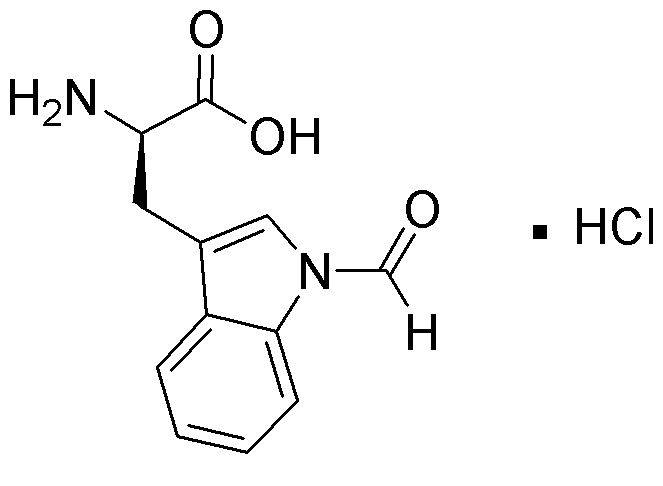Nin-Formyl-D-tryptophan hydrochloride is widely utilized in research focused on:
- Peptide Synthesis: This compound is used as a building block in the synthesis of peptides, particularly those that require specific structural configurations. Its unique formyl group allows for selective reactions, making it valuable in creating complex peptides for therapeutic applications.
- Neuroscience Research: It plays a role in studies related to neurotransmitter function and receptor interactions, particularly in the context of serotonin pathways. This can aid in understanding mood disorders and developing potential treatments.
- Drug Development: The compound is explored in the development of new pharmaceuticals, especially those targeting neurological conditions. Its ability to mimic natural compounds can enhance the efficacy of drug candidates.
- Biochemical Assays: It is utilized in various biochemical assays to study enzyme activity and protein interactions. This application is crucial for researchers looking to understand metabolic pathways and disease mechanisms.
- Antioxidant Studies: Researchers investigate its antioxidant properties, which can lead to applications in developing supplements or treatments aimed at reducing oxidative stress in cells, potentially benefiting various health conditions.
General Information
Properties
Safety and Regulations
Applications
Nin-Formyl-D-tryptophan hydrochloride is widely utilized in research focused on:
- Peptide Synthesis: This compound is used as a building block in the synthesis of peptides, particularly those that require specific structural configurations. Its unique formyl group allows for selective reactions, making it valuable in creating complex peptides for therapeutic applications.
- Neuroscience Research: It plays a role in studies related to neurotransmitter function and receptor interactions, particularly in the context of serotonin pathways. This can aid in understanding mood disorders and developing potential treatments.
- Drug Development: The compound is explored in the development of new pharmaceuticals, especially those targeting neurological conditions. Its ability to mimic natural compounds can enhance the efficacy of drug candidates.
- Biochemical Assays: It is utilized in various biochemical assays to study enzyme activity and protein interactions. This application is crucial for researchers looking to understand metabolic pathways and disease mechanisms.
- Antioxidant Studies: Researchers investigate its antioxidant properties, which can lead to applications in developing supplements or treatments aimed at reducing oxidative stress in cells, potentially benefiting various health conditions.
Documents
Safety Data Sheets (SDS)
The SDS provides comprehensive safety information on handling, storage, and disposal of the product.
Product Specification (PS)
The PS provides a comprehensive breakdown of the product’s properties, including chemical composition, physical state, purity, and storage requirements. It also details acceptable quality ranges and the product's intended applications.
Certificates of Analysis (COA)
Search for Certificates of Analysis (COA) by entering the products Lot Number. Lot and Batch Numbers can be found on a product’s label following the words ‘Lot’ or ‘Batch’.
Numéro de catalogue
Numéro de lot/série
Certificates Of Origin (COO)
This COO confirms the country where the product was manufactured, and also details the materials and components used in it and whether it is derived from natural, synthetic, or other specific sources. This certificate may be required for customs, trade, and regulatory compliance.
Numéro de catalogue
Numéro de lot/série
Safety Data Sheets (SDS)
The SDS provides comprehensive safety information on handling, storage, and disposal of the product.
DownloadProduct Specification (PS)
The PS provides a comprehensive breakdown of the product’s properties, including chemical composition, physical state, purity, and storage requirements. It also details acceptable quality ranges and the product's intended applications.
DownloadCertificates of Analysis (COA)
Search for Certificates of Analysis (COA) by entering the products Lot Number. Lot and Batch Numbers can be found on a product’s label following the words ‘Lot’ or ‘Batch’.
Numéro de catalogue
Numéro de lot/série
Certificates Of Origin (COO)
This COO confirms the country where the product was manufactured, and also details the materials and components used in it and whether it is derived from natural, synthetic, or other specific sources. This certificate may be required for customs, trade, and regulatory compliance.


